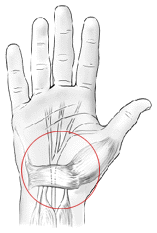Excessive repetitive movements of the arms, wrists or hands can cause injuries that could become chronic conditions. When detected early enough, however, hand and wrist injuries can be treated, and recovery is possible in a few months. Severe hand injuries can also be treated, but recovery may take up to a year or longer.

The carpal tunnel is the passageway in the hand made up of the arching carpal bones (eight bones in the wrist) and the ligament connecting the pillars of the arch. The median nerve and the tendons that connect the fingers to the muscles of the forearm pass through the tightly spaced tunnel. Carpal tunnel syndrome occurs when the median nerve, which relays sensation from the palm of the hand and fingers, becomes pinched, usually by swelling of the tendons. This leads to numbness and sometimes pain of the fingers, hand and sometimes the forearm.
What are the symptoms of carpal tunnel syndrome?
Usually, people with carpal tunnel syndrome first notice that their
fingers "fall asleep" and become numb at night -- they often
wake up and with numbness and tingling in their hands. Burning pain is
frequently associated with this feeling of numbness, and it generally runs
up the center of the person's forearm, sometimes as far as the shoulder.
As carpal tunnel syndrome becomes more severe, symptoms are noticed during
the day.
What happens in severe cases of carpal tunnel syndrome?
When chronic irritation occurs around the median nerve, it becomes
constricted and is continually pushed against the ligament above it. When
the median nerve in the hand is continually constricted, it can become
compressed to the point that it begins to deteriorate. This results in a
slowed transmittal of nerve impulses, which may cause a loss of feeling in
the fingers and a loss of muscle function at the base of the thumb. If the
condition is not treated, it could result in a deterioration of muscle
tissue.
Do certain medical conditions make people more likely to develop
carpal tunnel syndrome?
People with diabetes or metabolic conditions may be more likely to develop
carpal tunnel syndrome. These conditions affect the nerves directly,
making them more vulnerable to compression.
What tests can help diagnose carpal tunnel syndrome?
Often, an electromyogram, which includes nerve conduction studies, is done
to document the extent of nerve damage. An electromyogram is a test that
measures the electrical activity in your nerves and muscles. Nerve
conduction studies measure the ability of specific nerves to transmit
electrical impulses or messages.
The nerve conduction studies, however, will not become positive until there is significant nerve damage (degeneration). In addition, the severity of a person's symptoms are often not correlated with the findings of a nerve conduction study.
Two other useful tests for diagnosing carpal tunnel syndrome are the Tinel and Phalen maneuvers. Tingling sensations in the fingers caused by tapping on the palm side of the wrist is a positive Tinel test, whereas reproduction of symptoms by flexing the wrist is a positive Phalen test. Dr. Phalen created this maneuver many years ago when he was a hand surgeon at the Cleveland Clinic.
How is carpal tunnel syndrome treated?
Treatment first involves adjusting the way the person performs a
repetitive motion:
- Changing the frequency with which the person performs the motion.
- Changing the amount of time the person rests between periods of performing the motion.
Patients may be given short courses of anti-inflammatory drugs or injections of cortisone or steroids in their wrist to reduce swelling. Injections provide temporary relief and are best reserved for people who have carpal tunnel syndrome as a result of an acute (sharp or severe) flare-up of tenosynovitis (an inflammation of the sheath around the tendon). Injections also are used to treat people who have an inflammatory disease, such as rheumatoid arthritis.
If carpal tunnel syndrome does not respond to conservative treatment, then surgery is the next treatment option. During surgery, your surgeon will open the carpal tunnel and cut the ligament at the bottom of the wrist, relieving the pressure.
Carpal tunnel surgery is quite effective when the condition involves only nerve constriction. Relief of painful symptoms is excellent and nerve degeneration is almost always reversible.
When carpal tunnel syndrome is just one manifestation of cumulative trauma disorder (repetitive stress), the results of surgery are not always so good. The difficulty is not in recovering from the operation, but in recovering the ability to return to work, especially to the same job that caused the repetitive disorder to occur. Whether or not true carpal tunnel symptoms recur in these patients, many continue to have pain and are unable to use their hands to any great extent.
What can I do to prevent carpal tunnel?
- Sleep with your wrists straight
- Keep your wrists straight when using tools
- Avoid flexing and extending your wrists repeatedly
- Minimize repetitive motion and rest your wrists
- Perform conditioning and stretching exercises